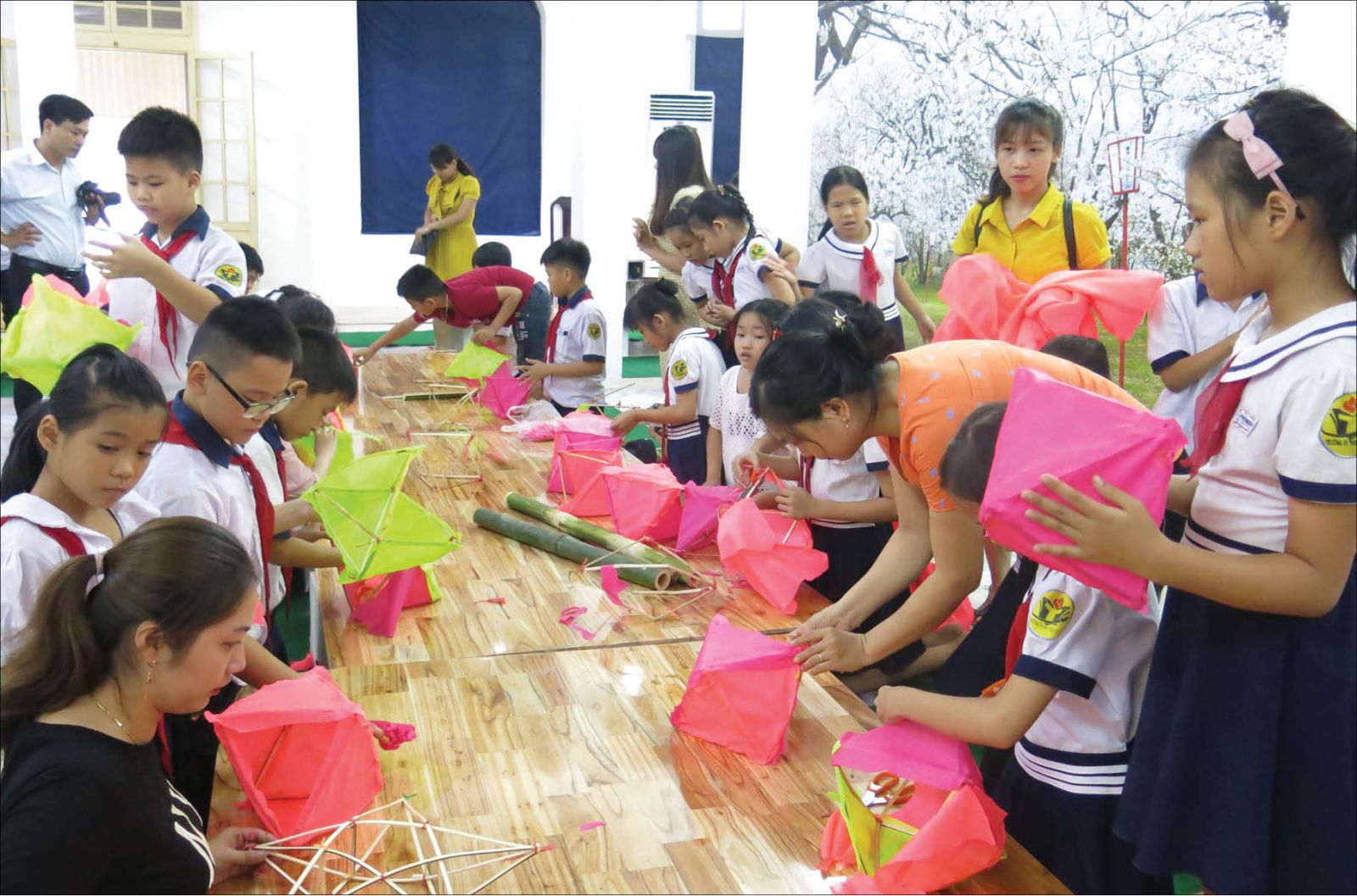Fostering the love for Hue culture

Duc Ward Primary School students experience the traditional crafts at Hue Cultural Museum
Experiencing heritage
Recently, the students of Duc Ward Primary School (Hue City) have enthusiastically joined in the traditional craft experience program at Hue Cultural Museum: printing Sinh Village paintings, making Hue traditional cakes, making lanterns and so on. Under the artisans’ guidance, the children excitedly formed molds, made cake kernels, wrapped cakes or made the pretty lanterns on their own.
Many students patiently printed Sinh Village paintings, and colored to create complete paintings. Vo Phuong Trang, a fourth-grade student, Ward Duc Primary School expressed his delight: "This experience is not only an occasion for entertainment but also a chance for me to further understand the uniqueness of Hue traditional craft, clearly know the formation history of the land where I was born when visiting the exhibition space: Thuan Hoa - Phu Xuan - Hue, from the ancient to modern city.”
In March, the students of Dang Van Ngu Lower Secondary School (Hue City) also had interesting experiences in the extracurricular sightseeing program "Hue, my hometown”. After visiting Tu Duc Mausoleum with the poetic scenery of heritage characteristic, we were also introduced to Hue singing art by poet Vo Que, Chairman of Ca Hue (Hue Traditional Singing) Club, and viewed the Ca Hue performance by the artists.
Woman teacher Nguyen Thi Viet, Head of History-Geography-Civic Education Division, Dang Van Ngu Lower Secondary School shared: "This is a significant program which helps students to understand the tangible and intangible heritage of the homeland to join hands to preserve; to absorb câu hò, điệu lý,( chanties, Ly tunes in the folk music developed in Central and South Vietnam), thereby contributing to fostering the love for the hometown and country ”.
In order to foster students' love for the hometown culture, many schools organized extracurricular programs such as visiting heritage, scenic spots; experiencing traditional crafts, cuisine culture; learning about Hue traditional singing, folk song tunes and so on.
The real experiences and perceptions through the assessment tests enable students realize the value of Hue heritage and culture.
However, not all schools, especially those in especially difficult areas, have the conditions to organize the programs. Each year, despite good conditions, the schools can only organize the programs 1-2 times on account of the constraints of time and budget.
Incorporated into the curricula since the 2019-2020 school year
Researcher Nguyen Xuan Hoa said that for a long time, the education sector only focused on teaching natural and social knowledge, but did not pay much attention to the education of Vietnamese culture in general as well as Hue history and culture in particular. A lot of students after graduation leave their hometown, but are not knowledgeable about Hue culture; it is a gap to be bridged at the macro level.
During the meeting with the DOET, Chairman of the Provincial People's Committee Phan Ngoc Tho emphasized that Thua Thien Hue’s students must be those who love Hue history and culture. The education sector must draw up the extracurricular programs for Hue's history and culture education for students at all levels, helping students turn towards their roots, ancestors, and Hue people’s character and so on.
"The guidance given by Chairman of the Provincial People's Committee is also consistent with the guideline issued by the Ministry of Education and Training on the implementation of the general education program innovation. From 2020, the local education program will be incorporated into the curricula with duration of 35 periods per school year, 1 lesson per week. In our province, the local education program will be implemented from the 2019-2020 school year,” said Mr. Nguyen Tan, Deputy Director of the DOET.
According to Mr. Nguyen Tan, the education of local history and culture for students at all levels is of crucial importance in nurturing the young generation’s love for the hometown and national cultural spirit. The insight into Hue culture should be gradually fostered when the children are young so that when away from Hue, they can be confident of introducing the native land’s culture, knowing how to process the typical dishes, how to perform the folk songs and so on. This is the responsibility of the education sector for the young generation. The knowledge of the local history and culture also contributes to the career orientation for students in conformity with the locality’s strengths.
In order to educate Hue history and culture in a methodical way, the local education program will be synchronously implemented from the preschool to upper secondary education level. The DOET will develop a specific and detailed program for each educational level with a view to introducing the beauty of Hue culture, the traditional values of Hue people, introducing the traditional crafts to students at each level.
The knowledge of local history and culture is also integrated in the subjects such as geography, history, civic education and literature. Mr. Tan said: “We will complete the set of textbooks, provide a mechanism to support the schools in accordance with the provincial project, and can mobilize the socialization sources. Along with planning the project, the DOET will train and foster the team of teachers to communicate the knowledge to students. ”
Researcher Nguyen Xuan Hoa proposed that the local culture education program should be systematically drafted from the preschool to upper secondary school level with the participation of researchers and scientists. In order for the local culture education program to be truly effective, not to make students pressured, it is important to create interest and stimulate exploration among students.
Aside from the knowledge, it is necessary to combine with the experiences through making sightseeing tours, inviting artisans, experts, artists to perform at school, performing arts, staging... The live perception will leave good impressions on children’s soul.
Story and photo: Minh Hien